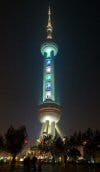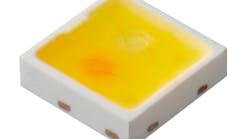Progress is already underway. The Chinese government has launched a national solid-state lighting (SSL) program, targeting huge energy savings from a large-scale conversion to LED lighting, as well as reduced environmental pollution.
Ling Wu, director of the China Solid-State Lighting Program Office, told the audience at the recent Strategies in Light conference that China could save 100 billion kWhr annually by 2015, if LEDs are able to reach 150 lm/W and achieve a 40% share of China's incandescent lighting market. Such savings would be more than the output of the massive Three Gorges hydroelectric project, she said.
The China National SSL Program kicked off in June 2004 when the Ministry of Science and Technology pulled together the activities of a number of different regional development groups. The program has already received 140 RMB ($17 million) from central government, and 15 research institutions and more than 50 enterprises are involved. Major investment in SSL is expected when China's 11th 5-year plan is unveiled in July 2005 (see China promotes energy efficiency using LED lighting).
The China SSL Program Office, under Ling Wu, has already initiated comprehensive strategy research, industry standard preparation, and IP research programs.
In October 2004, a group called the China R&D and Industry Alliance for SSL was formed, with the aim of improving the competitive ability of the country's industry. The group will develop mechanisms to share resources such as technology and IP, while encouraging regional collaboration and international cooperation.
According to Ling Wu, China continues to make progress with its LED development, with domestic companies supplying 12-mil blue chips at the 6-8 mW level (20 mA) and power chips at 120 mW (350 mA). Packaging companies are able to supply white LEDs at 20-25 lm/W when using domestic blue chips, and 30-35 lm/W using higher brightness imported chips - this statistic gives a good indication of the status of China's LED industry relative to the rest of the world.
Of course, China is a newcomer: as recently as 2002, the country's LED packaging industry imported all its blue chips, while the emerging domestic chip industry was able to supply 5% of demand in 2003. This figure grew to 20% in 2004, with Chinese companies also supplying GaN-based epiwafers, and a target of 40% is set for 2005.
China's LED industry had sales of RMB 12 billion ($1.45 billion) in 2004, up from RMB 10 billion ($1.2 billion) in 2003. Ling Wu estimated that more than 600 Chinese enterprises, with more than 40,000 employees in total, are directly related to the LED industry.
The country already has 4 national SSL industrial bases, in the cities of Dalian, Shanghai, Nanchang and Xiamen. A fifth base is under development in Shenzhen, the territory adjacent to Hong Kong. Representatives from Century Epitech were also present at Strategies in Light; the company is attempting to find tenants for the new Shenzen park. Foreign companies are incentivized by tax breaks, as well as the expectation of low labor costs.
Ling Wu was keen to emphasize that SSL is a key part of China's energy policy, and a major area of focus for the Chinese government. China's SLL roadmap is set to be unveiled at the China SSL Forum in Xiamen on April 12-15. At the same time, lighting contracts for the 2008 Olympic Games are expected to be announced, as well as a tripartite collaboration between Taiwan, China and Hong Kong.






